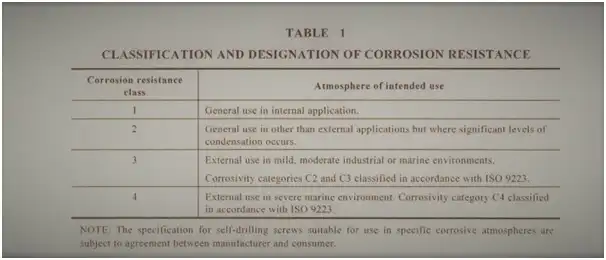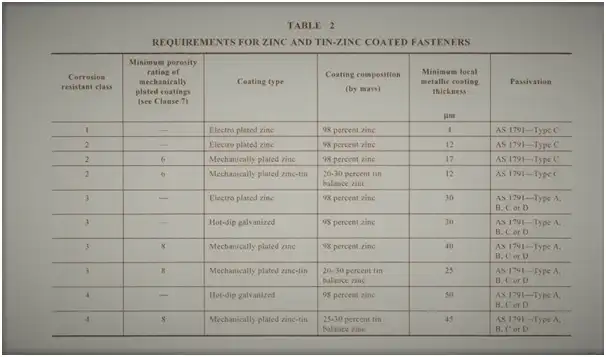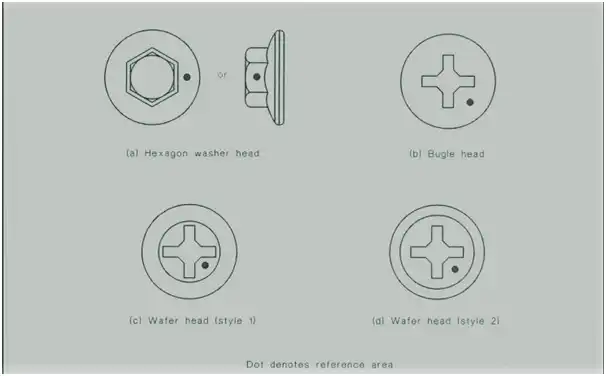In the Previous Article, we have discussed how a poor-quality roofing washer can play a significant role in promoting corrosion and causing accelerated deterioration of roofing materials and also the ways to avoid it. In this article, we will discuss on the specifications of the Corrosion Coating properties of the Fasteners through an analysis of the Class of coating and division.
In India there are no standards or Specifications of the Fasteners, hence we have to rely on foreign standards. The most detailed standards for fasteners are available with Australian Standards AS 3566 – 2002. This has last been updated in 2002.
It is prescribed in two parts. Part 1 describes the Technical Specifications and Mechanical requirements of the fasteners, which defines how a fastener has to be made for Cold rolled steel and Hot Rolled Steel and Part 2 describes the Coating properties which a Fasteners must process hence that would avoid corrosion on fasteners when installed. We will focus on part 2.
The need to have part 2 for corrosion requirements arises when the same fasteners were used inside the building / in moisture environment / in expose environment and near the sea. So each manufacturer started giving different coatings and started their own challenges. The pricing in the market was so difficult that the standards committee reached to a point where they define.
NEED OF THE CORROSION COATING PROPERTIES OF THE FASTENERS
Corrosion is both costly and dangerous. Billions of dollars are spent annually for the replacement of corroded structures, machinery, and components, including metal roofing, condenser tubes, pipelines, and many other items. In addition to replacement costs are those associated with maintenance to prevent corrosion, inspections, and the upkeep of cathodic ally protected structures.
Indirect costs of corrosion results from the shutdown, loss of efficiency, and product contamination or loss. Although the actual replacement cost of an item may not be high, the loss of production resulting from the need to shut down an operation to permit the replacement may amount to hundreds of dollars per hour.
CLASSIFICATION AND DESIGNATION OF THE CORROSION COATING PROPERTIES OF THE FASTENERS
The corrosion resistance of self-drilling screws shall be classified by the corrosivity of the atmosphere of intended use and designated as per Table 1.

REQUIREMENTS FOR CORROSION RESISTANCE
Class 1
Class 1 corrosion-resistant screws shall comply with one of the following requirements:
Accelerated testing
When Class I corrosion-resistant self-drilling screws are prepared in accordance with Appendix A and tested in a neutral salt spray in accordance with AS 2331.3.1 for 72 h red rust shall not be present over more than 5 percent of the significant areas of the screws and there shall be no blistering of the coating.
Zinc and zinc-tin coated screws
The metallic coating of zinc and zinc-tin coated Class 1 corrosion resistant screws shall be in accordance with Table 2. The local thickness of the metallic coating shall be determined in accordance with AS 2331.1.3 or AS 2331.1.4 and the minimum local coating thickness shall be determined from three local thickness measurements made on the reference surface shown in Fig 1.
Class 2
Class 2 corrosion resistant screws shall comply with one of the following requirements:
Accelerated testing
When Class 2 corrosion resistant self’-drilling screws are prepared in accordance with Appendix A and tested as follows red rust shall not be present over more than 5 percent of the significant surfaces of the screws and there shall be no blistering of the coating: (i) In a neutral salt spray in accordance with AS 2331.3.1 for 240h. (ii) In a condensing atmosphere containing sulfur dioxide at level KFW 2.0S in accordance with DIN 50018 fbr 5 cycles. (iii) The assessment of the level of rusting shall be conducted visually so that no doubt can exist that corrosion of the steel substrate is well established.
Zinc and zinc-tin-coated screws
The metallic coating of zinc and zinc-tin coated Class 2 corrosion resistant screws shall be in accordance with Table 2. The local thickness of the metallic coating shall be determined in accordance with AS 2331.1.3 or AS 2331.1.4 and the minimum local coating thickness shall be determined from three local thickness measurements made on the reference surface shown in Table 2.

Class 3
The exposed portion of the heads of Class 3 corrosion resistant screws shall comply with one of the following requirements:
Accelerated Testing
Class 3 corrosion resistant self-drilling screws prepared in accordance with Appendix A shall comply with the following requirements as appropriate:
- When tested in a neutral salt spray in accordance with AS 2331.3.1 for 1000 h red rust shall not be present over more than 5 percent of the significant areas of the screws and there shall be no blistering of the coating.
- When tested in a condensing atmosphere containing sulfur dioxide at level SFW 2.05 in accordance with DIN 50018 for 15 cycles, red rust shall not be present over more than 5 percent of the significant areas of the screws and there shall be no blistering of the coating.
- When non-metallic (organic) coated corrosion resistant self-drilling screws are tested in an atmosphere of 100 percent relative humidity in accordance with ASTM D2247 for 1000 h there shall be no blister size 53 or larger or a blister density of 1 or greater in accordance with AS 1580.481.1.9.
- When non-metallic (organic) coated corrosion resistant self-drilling screws are exposed to alternating ultraviolet and water with a test cycle of 4 h ultraviolet radiation of 60 degrees celsius and 4 h condensation at 50oC in accordance with ASTM Gl54 fcrr 2000 h there shall be no checking, cracking, or flaking and peeling with a rating greater than 0 in accordance with AS 1580.481.1.7. AS 1580.481.1.8 and AS 1580.481.1.10, respectively.
Outdoor exposure testing
When Class 3 corrosion resistant self-drilling screws are tested at an outdoor test site in accordance with Appendix B there shall be no red rust present on the significant surfaces of 95 percent of the fasteners tested i.e., 95 of the 100 screws in the test panel.
Zinc and zinc-tin coated screws
The metallic coating of zinc and zinc-tin coated Class 3 corrosion resistant screws shall be in accordance with Table 2. The local thickness of the metallic coating shall be determined in accordance with AS 2331.1.3 or AS 2331.1.4 and the minimum local coating thickness shall be determined from three local thickness measurements made on the reference surface shown in Figure 1.

Class 4
The exposed portion of the heads of Class 4 corrosion resistant screws shall comply with one of the following requirements:
Outdoor exposure testing
When Class 4 corrosion resistant self-drilling screws are tested at an outdoor test site in accordance with Appendix B there shall be no red rust present on the significant surfaces of 95 percent of the fasteners tested. i.e. 95 of the 100 scorers in the test panel.
Zinc and zinc-tin coated screws
The metallic coating of zinc and zinc-tin coated Class 4 corrosion resistant screws shall be in accordance with Table 2. The local thickness of the metallic coating shall be determined in accordance with AS 2331.1.3 or AS 2331.1.4 and the minimum local coating thickness shall be determined from three local thickness measurements made of the reference surface shown in Figure 1. Where a non-metallic coating is applied over a zinc or a zinc-tin coating the zinc or the zinc-tin coating shall be in accordance with Table 2, otherwise the requirements given in item (a) above apply.
Screws with solid non-metallic heads
Solid non-metallic heads of Class 4 corrosion resistant self-drilling screws shall be manufactured from an inherently ultraviolet radiation stable polymer or a polymer with appropriate long term stabilization against loss of mechanical integrity during service. The polymeric head coating shall have adequate integrity and adhesion such that failure by physical separation between the coating and steel base shall not occur during installation or subsequent service.
Inherently corrosion resistant screws
Class 4 inherently corrosion resistant self drilling screws shall be manufactured from the appropriate grades or compositions of stainless steel or other long life corrosion resistant materials. Where a long-life corrosion resistant coating is used on steel of stainless steel” the coating shall be capable of protecting the substrate in a category’ C4 environment in accordance with ISO 9223 for not less than 15 years.
Screws with non-porous zinc alloy coated heads
The coating on the screws with zinc alloy coated heads shall completely encapsulate the head and the minimum local thickness on the head shall be not less than 0.7 mm. Other alloying elements shall not significantly climinish the corrosion resistance characteristics of zinc. Corrosion resistance enhancement is acceptable. The coating shall have adequate integrity and adhesion such that failure by physical separation between the coating and the steel base shall not occur during installation or subsequent service.
ADHESION OF METALLIC COATINGS OF THE CORROSION COATING PROPERTIES OF THE FASTENERS
When a metallic coating on a self-drilling screw is scraped or sheared with a sharp edge such as a knife or razor through the coating to the substrate, the coating shall not flake.
POROSITY OF MECHANICALLY PLATED ZINC AND ZINC-TIN OF OF THE CORROSION COATING PROPERTIES OF THE FASTENERS
The porosity of mechanically plated zinc and zinc-tin coatings shall be as given in Table 2 for not less than 50 percent of the reference surface shown in Figure 1.
COMPATIBILITY CORROSION COATING PROPERTIES OF THE FASTENERS
No requirements for the compatibility of corrosion resistant self-drilling screws with other materials are specified. Manufacturers and purchasers should seek expert advice when manufacturing or selecting fasteners and accessories for specific applications to avoid galvanic corrosion of components of the system. Guidance on the prevention of galvanic corrosion is given in AS/NZS 2312.

Conclusion
When corrosion takes place, corrosion products build up, resulting in reduced flow in pipelines and reduced efficiency of heat transfer in heat exchangers. Both conditions increase operating costs. Corrosion products may also be detrimental to the quality of the product being handled, making it necessary to discard valuable materials.
When all of these factors are considered, it becomes obvious why the potential problem of corrosion should be considered during the early design stages of any project, and why it is necessary to constantly monitor the integrity of structures, bridges, machinery, and equipment to prevent premature failures. Though classes help in understanding the need and importance, there is still a lack of uniformity and clarity in pricing the products in India. People price the product without defining the coating and corrosion resistance capabilities.
You could get 25mm Screws in all the four Class.
| Class | Life Cycle Estimation |
| Class – 1 | 12M |
| Class – 2 | 36M |
| Class – 3 | 7 yr |
| Class – 4 | 15-20 yr |
It is for the intelligent to select the most economical product in the life cycle cost.
Contributed by an industry expert!



